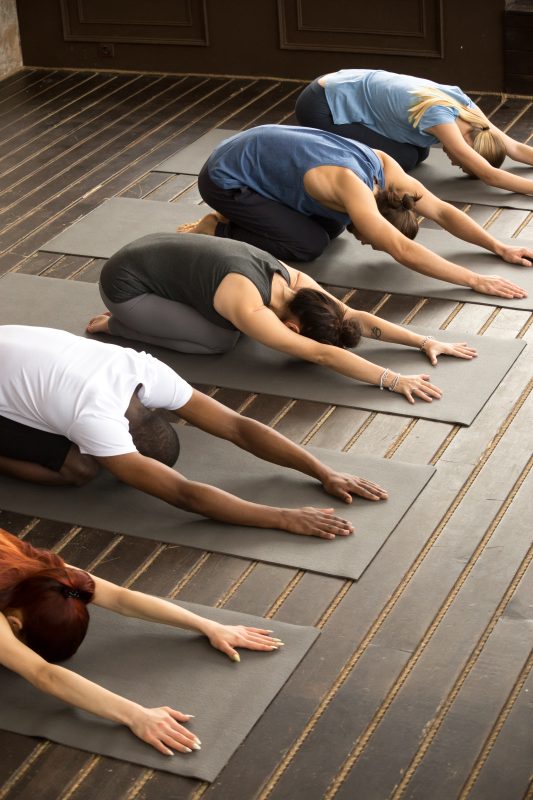Do you want to know the benefits of eco yoga mats?
Picture this: You’re in your favorite yoga class, flowing through a sun salutation, when suddenly you catch a whiff of that unmistakable “new mat smell.”
But what if I told you that scent isn’t the essence of zen you’ve been chasing, but rather a cocktail of chemicals that could be doing more harm than good?

As a yoga instructor with plenty of experience, I’ve seen trends come and go. But there’s one shift that’s not just a passing fad – it’s a revolution in how we approach our practice. I’m talking about eco-friendly yoga mats, and trust me, they’re about to change your downward dog game forever.
You might be wondering, “What’s the big deal? A mat’s a mat, right?” Wrong! The mat you practice on is like the foundation of a house – it can make or break your yoga experience. And just like you wouldn’t build a house on shaky ground, why would you build your practice on a mat that’s harmful to both you and the environment?
In this article, we’re going to spill the truth about eco-friendly yoga mats. We’ll explore how these green alternatives can enhance your practice, protect your health, and help you tread more lightly on our planet. From the surprising benefits to your balance and grip, to the peace of mind that comes from knowing you’re making a positive impact, we’ll cover it all.
So, whether you’ve been a yogi for years or you’re just a newbie, grab your reusable water bottle and get ready to dive into the world of eco-friendly yoga mats. Trust me, by the end of this read, you’ll be itching to make the switch. After all, shouldn’t your yoga practice be as kind to the Earth as it is to your body and mind? Let’s find out how you can say “Namaste” to both your practice and the planet.
Introduction to Eco-Friendly Yoga Mats
What are Eco-Friendly Yoga Mats?
Eco-friendly yoga mats are designed with both the yogi and the environment in mind.
Unlike traditional mats often made from PVC or other synthetic materials, these mats are created using sustainable, natural, and often biodegradable materials. Common materials include natural rubber, cork, organic cotton, and jute. These mats are free from harmful chemicals, making them a healthier choice for your practice and the planet.
Why opt for eco-friendly and sustainable yoga mats for sale?
The decision to switch to an eco-friendly mat goes beyond just following a trend.
It’s about aligning your yoga practice with broader principles of mindfulness and respect for the environment.
Here’s why I think making this switch is crucial:

Benefits of Eco Yoga Mats – The ecological advantages
Contribute to preserving our environment
By choosing an eco-friendly mat, you’re actively reducing your carbon footprint.
These mats are often made using sustainable manufacturing processes, which consume less energy and produce fewer emissions.
Meaning that the materials used are typically renewable resources, helping to conserve our planet’s natural resources.
Less waste
One of the biggest problems with traditional yoga mats is their end-of-life disposal.
PVC mats can take centuries to decompose in landfills.
In contrast, many eco-friendly mats are biodegradable or compostable.
Some can even be recycled, contributing to a circular economy and significantly reducing waste.

Benefits for your yoga practice
Comfort and stability
Eco-friendly mats aren’t just good for the environment; they’re excellent for your practice too.
Many of these mats offer superior grip and stability, especially when compared to traditional PVC mats.
Natural rubber and cork mats, for instance, provide excellent traction, even during sweaty practices like hot yoga.
Personal health – non-toxic
Traditional yoga mats often contain phthalates, heavy metals, and other harmful chemicals that can be absorbed through your skin or inhaled during practice.
Eco-friendly mats are typically free from these toxins, providing a safer surface for your practice.
This is especially important for those with allergies or sensitivities.

Long term investment
Money saving
While eco-friendly mats may have a higher upfront cost, they often prove to be more economical in the long run.
Their durability means you won’t need to replace them as frequently as traditional mats, saving you money over time.
Durability and resistance
Eco-friendly mats are designed to hold up to regular use without deteriorating.
Materials like natural rubber and cork are resilient and maintain their properties over time, ensuring your mat stays in good condition for years.
When a PVC mat is no longer useful, what happens to it?
This is a crucial question that highlights the importance of eco-friendly mats.
PVC mats typically end up in landfills where they can take hundreds of years to decompose, releasing harmful chemicals into the environment in the process.
This long-term environmental impact is one of the strongest arguments for switching to eco-friendly alternatives.

Why Do Yogis Use Rubber/Sticky Mats?
Rubber and sticky mats became popular due to their ability to provide stability and prevent slipping during practice.
However, as we’ve learned more about their environmental impact, many yogis are now looking for alternatives that offer similar benefits without the ecological drawbacks.
First There Was Yoga – Then Came The Plastic and Rubber
It’s worth remembering that yoga predates modern materials by thousands of years. Ancient yogis practiced on bare earth, grass, or animal skins.
While we’ve evolved from these practices, the principle of connecting with nature remains important.
Eco-friendly mats help bridge the gap between modern convenience and traditional values.

Cotton Flows – Rubber Blocks
A cotton yoga mat can aid in deepening your practice
Natural materials like cotton allow for a more grounded connection to the earth.
They’re breathable and absorb sweat well, making them ideal for certain types of yoga practices.
Some practitioners find that natural materials enhance their sense of connection during practice.
Conscious Consumerism
I believe that by us choosing an eco-friendly mat is an act of conscious consumerism.
It’s a way of voting with your wallet for more sustainable products and practices in the yoga industry.
This kind of consumer pressure can lead to broader changes in manufacturing and business practices.

Frequently Asked Questions
Are eco-friendly yoga mats as durable as traditional mats?
Yes, many eco-friendly mats are designed to be as durable, if not more so, than traditional mats. Natural rubber and cork mats, in particular, are known for their longevity.
Are eco-friendly yoga mats safe for people with allergies?
Generally, eco-friendly mats are hypoallergenic and safe for most people. However, those with latex allergies should avoid natural rubber mats. Always check the specific materials if you have severe allergies.
Do eco-friendly yoga mats provide enough grip and stability?
Absolutely. Many eco-friendly mats offer excellent grip and stability. Cork and natural rubber mats, in particular, are known for their non-slip properties, even in sweaty conditions.
Are eco-friendly yoga mats suitable for hot yoga or sweaty workouts?
Yes, many eco-friendly mats are designed with hot yoga in mind. Cork mats, for instance, actually increase in grip as they get wet, making them ideal for sweaty practices.
Can eco-friendly yoga mats be cleaned easily?
Most eco-friendly mats are easy to clean with mild soap and water. Some can even be machine washed. Always follow the manufacturer’s care instructions to maintain the mat’s quality and longevity.
Are eco-friendly yoga mats biodegradable?
Many eco-friendly mats are indeed biodegradable. Materials like natural rubber, cork, and organic cotton will break down naturally over time, unlike PVC mats.

In conclusion, eco-friendly yoga mats offer a multitude of benefits, from environmental sustainability to enhanced practice experience.
As yoga practitioners, embracing these mats allows us to extend our practice of mindfulness and respect for nature beyond the mat.
By making this simple switch, we can significantly reduce our environmental impact while potentially improving our yoga experience.
Remember, every small step towards sustainability counts.
So, the next time you’re in the market for a new mat, consider going eco-friendly.
Your practice, your health, and our planet will thank you. Namaste my friends!





